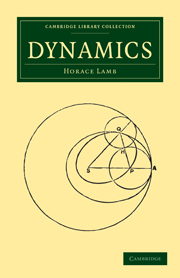Book contents
- Frontmatter
- PREFACE
- Contents
- CHAPTER I KINEMATICS OF RECTILINEAR MOTION
- CHAPTER II DYNAMICS OF RECTILINEAR MOTION
- CHAPTER III TWO-DIMENSIONAL KINEMATICS
- CHAPTER IV DYNAMICS OF A PARTICLE IN TWO DIMENSIONS. CARTESIAN COORDINATES
- CHAPTER V TANGENTIAL AND NORMAL ACCELERATIONS. CONSTRAINED MOTION
- CHAPTER VI MOTION OF A PAIR OF PARTICLES
- CHAPTER VII DYNAMICS OF A SYSTEM OF PARTICLES
- CHAPTER VIII DYNAMICS OF RIGID BODIES. ROTATION ABOUT A FIXED AXIS
- CHAPTER IX DYNAMICS OF RIGID BODIES (CONTINUED). MOTION IN TWO DIMENSIONS
- CHAPTER X LAW OF GRAVITATION
- CHAPTER XI CENTRAL FORCES
- CHAPTER XII DISSIPATIVE FORCES
- CHAPTER XIII SYSTEMS OF TWO DEGRESS OF FREEDOM
- APPENDIX. NOTE ON DYNAMICAL PRINCIPLES
- INDEX
CHAPTER VIII - DYNAMICS OF RIGID BODIES. ROTATION ABOUT A FIXED AXIS
Published online by Cambridge University Press: 07 September 2010
- Frontmatter
- PREFACE
- Contents
- CHAPTER I KINEMATICS OF RECTILINEAR MOTION
- CHAPTER II DYNAMICS OF RECTILINEAR MOTION
- CHAPTER III TWO-DIMENSIONAL KINEMATICS
- CHAPTER IV DYNAMICS OF A PARTICLE IN TWO DIMENSIONS. CARTESIAN COORDINATES
- CHAPTER V TANGENTIAL AND NORMAL ACCELERATIONS. CONSTRAINED MOTION
- CHAPTER VI MOTION OF A PAIR OF PARTICLES
- CHAPTER VII DYNAMICS OF A SYSTEM OF PARTICLES
- CHAPTER VIII DYNAMICS OF RIGID BODIES. ROTATION ABOUT A FIXED AXIS
- CHAPTER IX DYNAMICS OF RIGID BODIES (CONTINUED). MOTION IN TWO DIMENSIONS
- CHAPTER X LAW OF GRAVITATION
- CHAPTER XI CENTRAL FORCES
- CHAPTER XII DISSIPATIVE FORCES
- CHAPTER XIII SYSTEMS OF TWO DEGRESS OF FREEDOM
- APPENDIX. NOTE ON DYNAMICAL PRINCIPLES
- INDEX
Summary
Introduction.
When we pass from the consideration of a system of discrete particles to that of continuous or apparently continuous distributions of matter, whether fluid or solid, we require some physical postulate in extension of the laws of motion which have hitherto been sufficient. These laws are in fact only definite so long as the bodies of which they are predicated can be represented by mathematical points.
As to the precise form in which this new physical assumption shall be introduced there is some liberty of choice. One plan is to assume that any portion whatever of matter may be treated as if it were constituted of mathematical points, separated by finite intervals, endowed with inertia-coefficients, and acting on one another with forces in the lines joining them, subject to the law of equality of action and reaction. In the case of a ‘rigid’ body these forces are supposed to be so adjusted that the general configuration of the system is sensibly constant. On this basis we can at once predicate the principles of Linear and Angular Momentum, as developed in the preceding Chapter. These principles will be found to supply all that is generally necessary as a basis for the Dynamics of Rigid Bodies.
Information
- Type
- Chapter
- Information
- Dynamics , pp. 150 - 172Publisher: Cambridge University PressPrint publication year: 2009First published in: 1923
